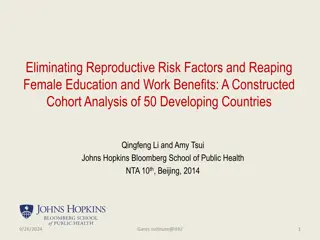Challenges in Education Systems of Developing Countries
The current trends in education in developing countries reveal ongoing challenges with access, retention, and learning outcomes. Despite improvements in primary school enrollment rates, dropout rates remain a concern. Many pupils are performing below low learning benchmarks, indicating issues with reading comprehension and basic skills. Addressing these challenges is crucial for ensuring effective education systems in low-income countries.
Download Presentation

Please find below an Image/Link to download the presentation.
The content on the website is provided AS IS for your information and personal use only. It may not be sold, licensed, or shared on other websites without obtaining consent from the author. Download presentation by click this link. If you encounter any issues during the download, it is possible that the publisher has removed the file from their server.
E N D
Presentation Transcript
From Access to Learning: System effects that continue to delay children s ability to learn. Ania Chaluda Education Policy and Data Center, FHI 360 achaluda@fhi360.org
Current trends in education in developing countries While access to primary education has been improving Primary school entry and participation in low income countries gross enrollment rate gross intake rate 140 120 100 80 % 60 40 20 0 2001 2008 2000 2002 2003 2004 2005 2006 2007 2009 2010 2011 2012 2013
Current trends in education in developing countries retention is still a challenge. Average primary school dropout rates in low income countries, most recent data available 20 16 1616 1618 13 13 15 10 10 11 11 9 9 9 9 10 % 7 7 7 7 7 6 5 5 4 4 3 3 5 0
Current trends in education in developing countries And so is learning. Percentage of pupils performing below a low learning benchmark SACMEQ 2007 100 80 44 60 37 27 % 22 21 20 40 19 14 12 11 11 8 4 1 20 0 Low Level of Learning in SACMEQ: Interprets meaning (by matching words and phrases, completing a sentence, or matching adjacent words) in a short and simple text by reading on or reading back.
Current trends in education in developing countries Percentage of pupils performing below a low learning benchmark Percentage of pupils performing below a low learning benchmark SACMEQ 2007 PIRLS 2006 100 78 SACMEQ 2007 80 44 60 100 37 % 27 22 40 21 20 19 80 14 12 11 11 8 4 4 3 2 20 1 1 60 44 37 % 0 27 40 22 21 20 19 14 12 11 11 8 20 4 1 0 Low Level of Learning in SACMEQ: Interprets meaning (by matching words and phrases, completing a sentence, or matching adjacent words) in a short and simple text by reading on or reading back. Low Level of Learning in PIRLS: Able to recognize, locate, and reproduce explicitly stated details from the texts, particularly if the details were close to the beginning of the text. Also demonstrates success with some items requiring straightforward inferences.
How many children are really able to read? Let s not forget about those children who never reached the tested grade
Learning Pyramid Primary School Entry Population: usually 6 or 7 year olds
Learning Pyramid Access: 14 year olds who have ever attended school a generous measure of school participation
Learning Pyramid Survival: the percentage of pupils in grade 1 who eventually reach a given grade, regardless of how many times they repeat
Learning Pyramid Learning: the percentage of pupil in a given grade who have reached the low level of learning according to a given assessment test
Learning Pyramid An ideal school system:
Learning Pyramid data sources Demographic Household Surveys, Multiple Indicator Cluster Surveys Access Demographic Household Surveys, Multiple Indicator Cluster Surveys, UNESCO Institute for Statistics (UIS) Survival Learning SACMEQ, PIRLS, SERCE and PASEC
Learning Pyramid results for Sub-Saharan Africa 44 50 37 40 27 22 21 20 30 19 Percentage of students below the low level of learning 14 % 12 11 11 20 8 4 1 10 0
Conclusions While developing countries have made significant progress towards increasing enrollment levels, available student assessment data shows that in many of these countries, students don t learn enough The scope of the problem is emphasized when we look at other aspects of education systems, including access and retention The current state of learning in developing countries demands focus and new creative interventions to improve instruction and increase student achievement
Thank you Please visit us at www.epdc.org for more info























